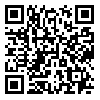Volume 11, Issue 2 (8-2020)
2020, 11(2): 77-92 |
Back to browse issues page
Dept. of Soil Sci., Faculty of Agric., Univ. of Zanjan, Iran
Abstract: (1384 Views)
Intercropping in compared to monoculture can increase yield sustainability. Deficit irrigation as a limiting factor for growth, affects the plant's yield characteristics. Therefore, The aim of this study was to investigate the effect of cultivation type: monoculture tomato (T), monoculture basil (B) and intercropping (50T:50B), and different moisture levels including four irrigation periods based on soil field capacity (FC): irrigation without water stress in the root zone 0.85‒1FC, and deficit irrigation levels of 0.7‒0.85FC, 0.5‒0.7FC and 0.3‒0.5FC, with a factorial arrangement (with two factors) in a completely randomized design and a total of 12 treatments in three replications. Plant characteristics including greenness index, stomatal conductance, leaf area index, leaf temperature and fresh and dry weights were measured. Based on the results, the highest fresh and dry weights of aerial part of the tomato were obtained in 0.7‒0.85FC treatment with intercropping (349.73 and 69.42 g per plant) and their lowest values were obtained in the irrigation level 0.3‒0.5FC with monoculture (204.66 and 40.42 g per plant). Tomato leaf area index was not significantly decreased up to water stress level of 0.5‒0.7FC. For basil, the highest fresh and dry weights of the plant (91.71 and 16.39 g per plant) and leaf area index (1845.99 cm2 per plant) were obtained in monoculture, and at non-stress level and 0.7‒0.85FC, respectively. Tomato was dominant in intra-specific competition with basil and significantly influenced basil yield. Finally, according to the results of this study intercropping of basil and tomato and water level up to 50% of field capacity resulted in reduction of water loss and increased fruit yield of two plants by considering consumed water.
Type of Study: Applicable |
Received: 2019/07/20 | Accepted: 2020/08/31 | Published: 2020/08/31
Received: 2019/07/20 | Accepted: 2020/08/31 | Published: 2020/08/31
Send email to the article author
| Rights and permissions | |
 |
This work is licensed under a Creative Commons Attribution-NonCommercial 4.0 International License. |







